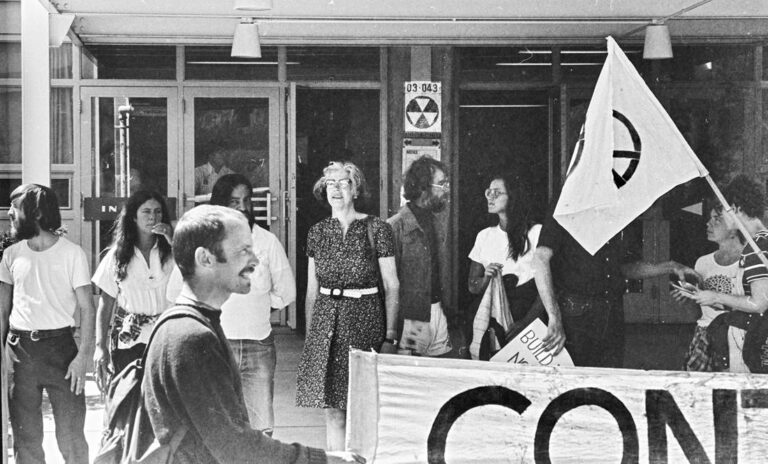The Magic of the Archive
The first photograph I came across in the War Resisters League Records was unexpected. Well, I say photograph, but really it was a black-and-white negative strip with four images. The images were of a group of four people (friends? I’ve been encouraged to avoid assumptions, judgments, and storytelling in my descriptions, but this won’t be archived as a permanent, unbiased description because this is how the images fall into my story, so…) Let’s say it’s a group of friends. They’re in a car. They’re likely part of the War Resisters League at the time. I don’t know, we don’t know. That’s kind of the point. The first two images on the strip are similar to each other; the only obvious difference is that the second is a rotated version of the first. The first is a snapshot of the backseat of the car, likely taken by the passenger in the front seat. It’s candid; that is, mostly unposed. Real. A young woman smiles at the camera, her hands on the man with long hair and a beard that lies down in her lap. His eyes are closed, eyebrows furrowed as if in deep concentration. His hand rests on the young woman’s bare thigh. The car seems full; not only of the four friends but of things in the back. I wonder how the driver can check behind her. I suppose that’s the benefit of having three others in the car with you: extra heads to turn, extra eyes. Well, except for the man whose eyes are closed. The second image seems to be taken quickly after the first; the camera has rotated, the young woman’s smile has grown only a minuscule amount, and now we can see that her legs are outstretched, and it seems that what I thought was a car might have been a van all along.

The third image on this strip is of the driver’s side profile, likely also taken by the passenger in the front. She wears sunglasses and smiles softly, looking ahead. The fourth image is taken from the backseat and shows the two women who sit in the front. They seem to be in conversation. The driver’s arms are not visible; it is almost as if she is not driving, as if she was placed in this image as a non-participant. In this final image, the surroundings are visible through the windshield: a bridge. This looks like a film set to me. Key words: looks like. It’s not one, I know that. But it could be…
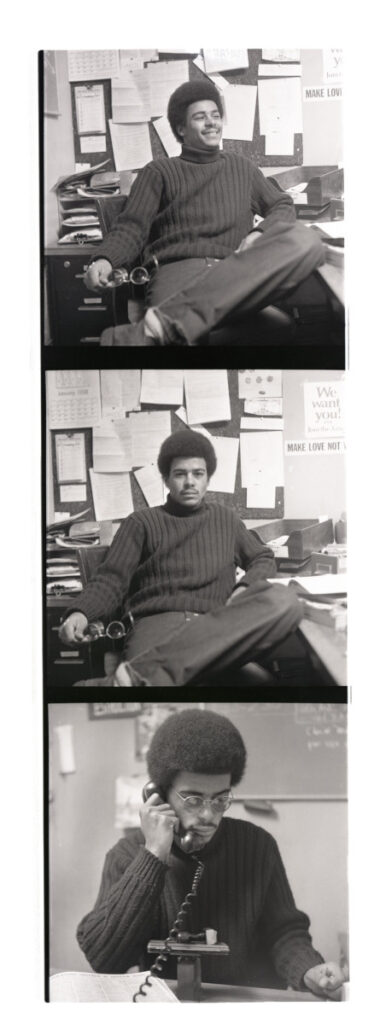
I was astonished by these images because working in an archive for the WRL, one would expect thousands of negatives that, when digitized, are realized as images of folks carrying signs and protesting in peace demonstrations. And of course, I’ve found many of these kinds of images. That’s the majority of my work, and it’s important work. (What march is Grace Paley off to now, anyway?) So when I came across an envelope marked “misc.,” full of 36 black-and-white negative strips each with two to three images, I wasn’t expecting to find so many fun and organic images too—two coworkers (dare I say friends!) taking turns posing at an office desk on the phone, the last shot capturing the wide-toothed laughter one broke into, which I imagine must’ve filled the room with joy, a group of people, presumably a family, fishing in a creek, and seemingly random appearances of a large dog who managed to get his own strip of three portraits by the end of the folder.
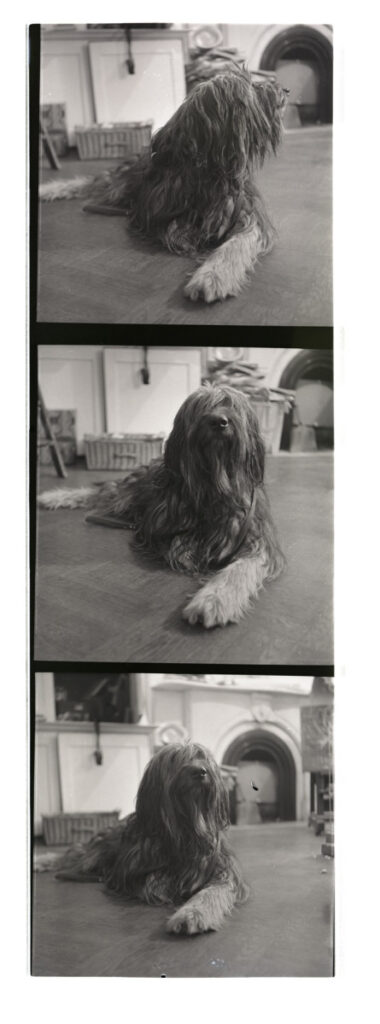
It’s no secret that any researcher’s or archivist’s favorite surprise in any collection is photos of dogs. A massive, long-haired shepherd dog might even be the best case scenario. So many photos of him! Why? Who knows? Who cares? (We care, of course.) Aren’t we glad we’re seeing a dog, probably 50 or so years ago, swimming in a lake? Or 12 images of him lying on the ground, putting his head up to the sunlight coming in through the window? I still haven’t begun to figure out whose dog this is, by the way. Or why someone took these images of him. It makes me think of myself as a child, playing with the digital camera my family had for several years, snapping close-up images of my father in his parents’ guestroom, my brother in the ocean. “Wait, wait,” I would say, giggling. “Let me take a picture.” It seemed trivial and random at the time. Because we moved around a bit chaotically while I was on the cusp of 12 years of age, we lost most of those pictures. I don’t know where they are. Sometimes I imagine them in my head; were most of them goofy? Would they make me cry now? The images of this dog may seem random, too, but they found their way into the WRL archive. Isn’t that funny? And I can say, although I know I’m not supposed to assume this professionally, and this is maybe all I know about him, he was loved. I’m glad we can remember a big silly dog like this.
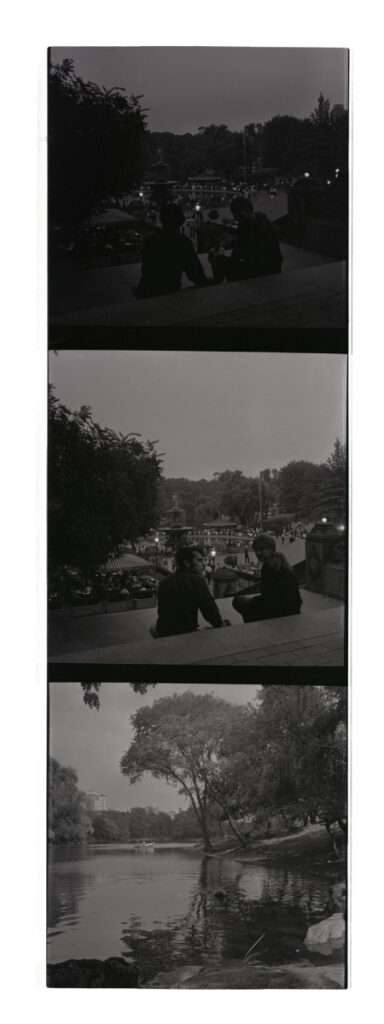
In another envelope of undated black-and-white negative strips, I stumbled upon two images of a couple sitting on wide concrete steps near a large public fountain. The photographer shoots this from behind, so we see the couple facing the fountain in the distance. It’s busy; many folks sit or walk closer to the fountain. It’s getting dark outside; in fact, it’s a bit difficult to make out specific details, but there are a few bright light posts near the fountain that anchor the image’s lighting. Despite the crowd below, the image still manages to portray a kind of intimacy—between the two subjects, of course, but between the subjects and the photographer too. In the first image, the woman, whose face is almost completely unreadable as dusk approaches, turns her head over her shoulder and looks back at the photographer. Between them, a sort of intimate tie, a knowing. You’re taking a photo of me and I’m looking. Who knows if the man next to her, facing forward, is aware he is being photographed? I think I can see a slight wrinkle in the corner of the woman’s eye. Maybe she’s smiling.
The second image seems better adjusted to the lighting. Things are clearer. While the woman maintains eye contact with us and we see more details in her face, we now see the side profile of the man—thick sideburns and half a widow’s peak—as he turns his head slightly back. He’s not looking at us though; his eyes are searching elsewhere behind the woman. It’s the few inches of space between this pair and the slight, hesitant?, leaning towards one another, that suggests a close relationship—lovers? Friends? Even just coworkers in the WRL?—I’m unsure, and it’s not my place to say. What I can say is it’s meaningful. The nuance of it all. I’m uncertain if, in the moment the image was taken, the photographer or participants found it to be all that meaningful. It’s impossible to say if that was just another dusk at Central Park spent overlooking Bethesda Fountain, just another few hours after work, or if it was special to them. But at this point in time, almost half a decade later, it’s special to me.
Since I’ve been working with WRL materials at the Swarthmore College Peace Collection, I’ve become enthralled by my own personal forms of archiving. I finish school here in December—a semester later than all of my friends who graduated this spring. Within these past few weeks, my friends and I have (mostly) finished uploading our hundreds of photos and videos of us over the years to a shared Google Drive folder. Within each friend’s individual collection, I am reminded of both spontaneous excursions and mundane moments between the group; I realize that our effort to put this archive together has created something tangible—a kind of souvenir of friendship. The archive helps activate my memory sometimes when things feel fuzzy, when the dorm apartment I used to come back to after class full of my best friends feels almost forgettable. I couldn’t have anticipated how abruptly I would lose that laughter every night.
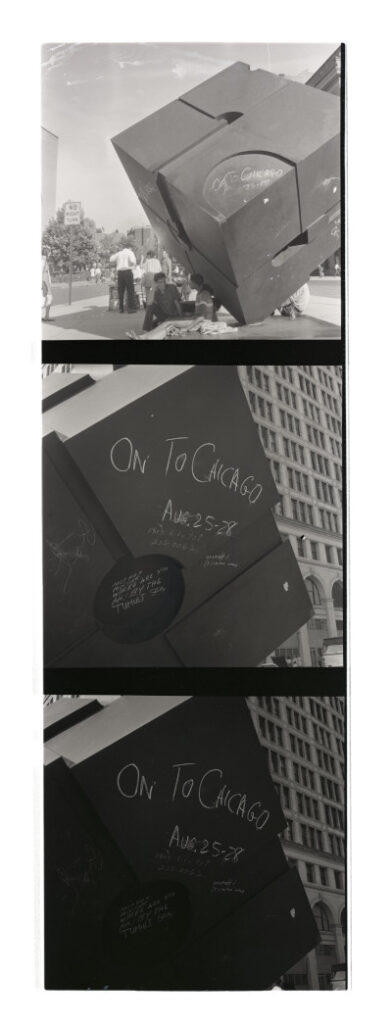
At first, I thought archives were scary. I guess permanency looms as a kind of authority, but I know it’s not a refusal for change or growth. It’s just a reminder. It’s important to remember the good, the bad, and everything in between. Because time can be confusing or overwhelming, certainly omnipresent, forever passing, or, as Grace Paley writes, “Because I don’t understand how time passes“, I cherish the things we carry into our archives. I also cherish the things I discover in archives that aren’t mine. These images are not my memories, but they do act as a sounding board for them. I can look at an image, maybe two people sitting under the Alamo sculpture in the East Village, and see myself in their body language. Oh, I’ve sat with my elbow resting on my knee, leaning into someone I’m getting to know like that too. Maybe that’s not the case for them. Regardless, I’ll never get tired of these connections we make as archivists. As I pull out more mysterious negatives or slides from the WRL Records to digitize, handling each object with care and wonder, I imagine how I’ll continue to record the temporality of my own life, create my own archive, in writing and photographs. I think about my own beautiful moments—some of which I have photos. Oh, we were in love for a moment. A moment? Thank god we captured that moment.
-by Tiffany Wong-Jones
Tiffany Wong-Jones is part of the team of staff and students busily digitizing visual and audio materials from WRL’s permanent archive at Swarthmore College Peace Collection. Click Here to view the WRL Miscellaneous Slides (1976 collection) Tiffany also worked on.
Share


